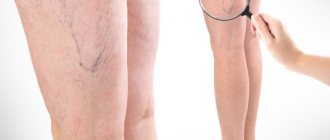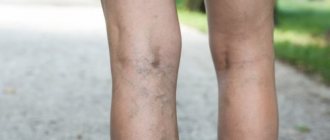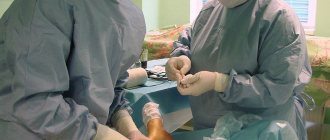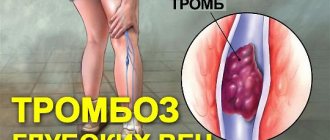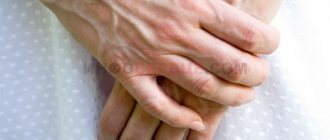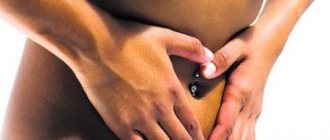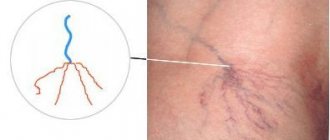What are uterine varicose veins
First, let's define the term, what it is: varicose veins of the uterus. The problem usually develops in one area of the organ, although situations with multiple lesions also occur. In an advanced state, the disease covers all organs of the female pelvis.
When the veins dilate in the legs, internal dysfunction develops. It is provoked by excess load. In this situation, the vessels on the walls or cervix are affected. Often the problem also affects the fallopian tubes. Women between 25 and 45 years old suffer from this disease. The disease can develop first in the uterus, and then spread to the entire perineum.
Vessels dilate in different ways. They are able to lengthen, their walls become thinner, and nodes form. The disease is either total or isolated. In the second situation, only the ovarian, arcuate or parametric veins are affected. With the arcuate type of disease, expansion of the uterine parametrium usually occurs simultaneously.
Diagnostics
Diagnosing varicose veins in a woman’s uterus is difficult due to the lack of specific symptoms.
A doctor cannot make a diagnosis based on a visual examination alone. Therefore, even if there is a slight suspicion of the presence of this disease, the patient is prescribed an additional comprehensive examination. Which includes:
- MRI of the pelvic organs;
- laparoscopic examination;
- phlebography of vessels of the pelvic organs;
- selective ovariography;
- Dopplerometry;
- Ultrasound examination of the pelvic organs.
Ultrasound is performed in 2 ways:
- Transvaginally, i.e. using a special sensor that is inserted into the woman’s vagina;
- Transabdominal, i.e. using a sensor through the woman's abdominal wall.
The transvaginal ultrasound diagnostic method is considered the most accurate.
Symptoms of varicose veins
The likelihood of varicose veins can be determined only by two characteristic symptoms:
- development of chronic pain in the lower peritoneum, intensifying during sexual intercourse, physical activity, before menstruation and during pregnancy;
- increased vaginal discharge.
Vulvar varicose veins
With ordinary vulvar varicose veins, the expansion of the veins is noticeable visually. There are complaints of discomfort, powerful bursting pain felt in the genitals. Examination reveals swelling of the labia. Sometimes spontaneous bleeding is added; it is usually provoked by childbirth or sexual intercourse.
Prevention
In order to minimize the risk of developing varicose veins in the uterus. It is necessary to follow the rules of a healthy lifestyle:
- Adhere to a correct and balanced diet of proteins, fats and carbohydrates;
- to live an active lifestyle;
- regularly engage in sports and physical activity;
- regularly visit a doctor for preventive examinations;
- drink enough water;
- additionally take multivitamin and mineral supplements.
Varicose veins in a woman's uterus are becoming an increasingly common disease every year.
This is due to a decrease in physical activity, deterioration of nutrition, and negative environmental influences.
This in turn provokes disruptions in the hormonal system.
However, despite the difficult diagnosis of varicose veins of the uterus, most cases are successfully treated. This disease poses the greatest danger to pregnant women. But timely treatment significantly reduces the risk of complications.
Treatment of varicose veins of the pelvis
If pathology is detected in a timely manner, complex therapy is prescribed. It is based on multi-stage treatment. In advanced situations, surgery is required.
Basic treatment
The main treatment is divided into several phases:
- physical activity while reducing stress;
- ban on alcohol and nicotine;
- diet adjustments;
- cold and hot shower;
- comfortable compression garments;
- quality sleep.
Drug treatment
Therapy involves the prescription of medications. Effective tablets: Troxerutin, Detralex or Anavenol. When the walls of the uterine vessels narrow, blood clots are likely. To prevent them, blood thinning medications are prescribed, although they have contraindications. Such drugs are prohibited in the presence of bleeding.
Surgical treatment of varicose veins
Surgical treatment consists of the following actions:
- resection of blood vessels;
- uterine excision.
Intermediate techniques have been developed to avoid radical organ removal.
Non-invasive methods
If it is impossible to relieve pain, minimally invasive intervention methods are recommended. Embolization or scleroobliteration of the ovarian veins is often prescribed. At the time of the operation, a sclerosant is launched into the vessel or an embolization coil is introduced.
An alternative is excision of the ovarian veins. When retroflexion of the uterus creates a problem, plastic surgery of the uterine ligaments is performed.
Invasive methods
In a situation with vulvar varicose veins, phlebectomy in the perineal area is recommended. It is often supplemented by excision of the labia. When the problem is combined with varicose veins of the legs, crossectomy is indicated.
Treatment of pathology
Treatment of varicose veins of the uterus includes a set of actions aimed at eliminating factors of increased risk of developing the disease, increasing vascular tone, preventing thrombus formation, normalizing blood circulation in the pelvic area and adjusting the diet.
A conservative course of treatment for varicose veins of the uterine vessels includes:
- Venotonic preparations based on diosmin, hesperidin, dihydroergotamine, horse chestnut and grape seed extract. Trade names of the drugs are “Venarus”, “Angistax”, “Detralex”, “Phlebodia”, “Eskuzan”.
- Oral antiplatelet agents (including vitamin P derivatives). For bleeding, hemostatic agents are taken, and for severe pain, non-steroidal anti-inflammatory drugs (indomethacin, diclofenac, etc.).
- A special set of exercises designed to improve blood circulation in the pelvic area (for example, Kegel exercises).
- Wearing compression garments, resting in the “legs above the body” position.
- Water procedures with contrasting water temperature, increasing the tone of the veins.
- Quitting alcohol and smoking.
- Diet correction (introduction of products that reduce blood viscosity, as well as complexes or sources of iodine).
- Compliance with the water norm (1.5-2 liters of fluid per day).
- Physiotherapeutic procedures.
- Taking vitamin complexes (E, C, P, B1).
- Avoiding intense physical activity.
For successful treatment it is also necessary to exclude the influence of risk factors.
Surgical methods for treating veins - phlebectomy, laser and radiofrequency coagulation, sclerotherapy and uterine resection - are used in the later stages of the disease if conservative therapy is ineffective.
Compared to a standard clinical case, many difficulties arise with how to treat uterine varicose veins in a pregnant woman. Due to a certain risk of negative effects of oral medications on the fetus, conservative therapy for varicose veins in the uterus during pregnancy includes diet, taking multivitamin complexes and plant-based veinotonics, physiotherapy, contrast water procedures and wearing compression garments.
Causes
The pathology is caused by the following reasons:
- heredity;
- hormonal imbalance;
- abortions;
- lack of treatment for inflammation;
- disruption of the menstrual cycle;
- pathology of vascular valves;
- pathologies of the hematopoietic system;
- bend of the uterus.
Provoking factors
In addition to the main reasons, there are factors that provoke the likelihood of such an illness:
Infusion of celandine for oral administration - how to use tampons for endometriosis
Accumulation of fluid in the uterine cavity in old age
Secondary (false) amenorrhea in women
Electrophoresis, magnetic therapy, physiotherapy for endometriosis
- overweight;
- the need to stand or walk for a long time;
- poor physical activity;
- use of shapewear;
- sexual dysfunction;
- frequent births.
Course during pregnancy
This period of the patient’s life is quite responsible, since as pregnancy progresses, all the symptoms and manifestations of uterine varicose veins intensify. Fetal growth provokes compression of the main veins, causing an increase in venous pressure in the lower half of the body.
Also, changes in hormonal levels contribute to greater relaxation of the smooth muscles of organs and blood vessels, which causes a decrease in tone and resistance to stress in the latter. To ensure the normal supply of blood to the enlarged uterus and fetus, its volume increases, which puts an even greater load on the vessels that are accustomed to less blood.
Also, in order for the fetus to receive more nutrients, the blood flow increases, this phenomenon helps to increase its outflow through the veins, which causes their significant expansion.
In this case, during pregnancy, the venous system contains quite large volumes of blood, and the valves are not able to hold it - insufficiency develops. And constant exposure to high pressure leads to expansion of the vascular walls.
During pregnancy, complications of varicose veins are dangerous:
- Thrombophlebitis is a phenomenon of blockage and stagnation in venous vessels with the addition of an inflammatory process;
- Thrombosis of the ovarian veins - leads to toxic damage to these organs, as well as severe pain;
- Hormonal imbalance, which can lead to termination of pregnancy;
- Placental insufficiency will negatively affect the condition of the unborn baby and can lead to placental abruption, fetal hypoxia and intoxication.
How to treat varicose veins of the uterus
Treatment of varicose veins of the uterus is carried out using medicinal and surgical methods. Therapy is combined with lifestyle correction. Give up bad habits and start eating right. The diet includes fresh vegetables and fruits, dairy products, and iodine-rich foods. Physical activity should be moderate. The drug therapy regimen includes:
- Venotonics (Detralex). The drugs improve blood properties and increase the tone of vascular walls. Used orally in long courses.
- Antiplatelet agents (Aspirin). Reduce blood viscosity, normalizing blood circulation in the veins of the pelvis. Regular use of this group of medications helps avoid the formation of blood clots.
- Anticoagulants (Heparin). Used to prevent thrombosis and eliminate venous stagnation. Prescribed after a blood test for clotting.
Important information: Is it possible to massage the lower extremities (legs) with varicose veins (varicose veins) and how to do self-massage at home
Surgical intervention
Surgical interventions are used for advanced forms of cervical varicose veins. The most effective operations include:
- Miniphlebectomy. Through small incisions, the affected areas of the vein are identified and removed. Blood circulation is normalized, signs of varicose veins disappear.
- Sclerotherapy. A chemical substance is injected into the cavity of the dilated vessel, blocking the lumen. Blood flow through the affected veins stops, causing them to disappear over time.
- Laser coagulation. Stimulates the formation of connective tissues that close venous lumens. Varicose nodes are reduced after surgery.
- Hysterectomy. Removal of the uterus is used for ruptures of large vessels accompanied by severe bleeding. The organ can be removed separately or together with its appendages.
Folk remedies
You can cure varicose veins of the uterus at home using the following remedies:
- Chestnut infusion. For preparation you will need 100 g of crushed fruits and 0.5 liters of vodka. The ingredients are mixed, the mixture is kept in a dark place for a week. Take tincture 30 drops, dissolving in a glass of warm water. Chestnut strengthens the walls of blood vessels and eliminates signs of inflammation.
- Herbal mixture of knotweed, dandelion and horsetail. Herbs are mixed in equal proportions, 2 tbsp. l. raw materials are poured into 0.5 liters of water and left in a thermos for 12 hours. The infusion is taken 50 ml before each meal.
- Infusion of birch leaves with honey. 100 g of fresh leaves are poured into 1 liter of water and left for 6 hours. The finished infusion is filtered, mixed with 50 g of honey and 25 ml of apple cider vinegar. The product is taken in the morning, 200 ml.
- A collection of walnut, sow thistle and birch leaves, apple flowers and wormwood stems. The components are taken in equal proportions, 100 g of the collection is poured into 0.7 liters of boiling water, and cooked over low heat for 20 minutes. The product infused for 5 hours is filtered and mixed with 30 g of honey. The liquid is consumed 3 times a day, 70 ml.
Important information: How to treat vein disease in the legs in men and what are the symptoms of varicose veins in the lower extremities
Exercises
For varicose veins of the uterus, treatment is supplemented with gymnastics. The following exercises help restore blood circulation in the pelvis:
- Squats. The back is straightened, the arms are extended forward, the pelvis is pulled back in the same way as when sitting down on a chair. It is recommended to perform at least 40 squats per day.
- Raising the pelvis. In a lying position, the legs are bent at the knees and placed on a chair. The arms are extended along the body, after which they begin to lift the pelvis. The actions are repeated at least 10 times, holding the pelvis in the air for 5 seconds.
- Mikulin exercise. Simple steps help get rid of signs of varicose veins of any location. With a straight back, they rise on their toes, after which the heels are lowered. The exercise is performed 30 times, take a short break and repeat the steps.
Why is it dangerous?
Varicose veins of the uterine veins are dangerous due to the development of complications such as:
- varicose veins of the ovaries;
- menstrual irregularities up to the occurrence of amenorrhea;
- thrombosis and thrombophlebitis of the pelvic veins;
- thrombosis of the ovarian veins.
Varicose veins of the uterus during pregnancy are dangerous due to impaired blood flow in the placenta, in which the fetus does not receive enough oxygen and nutrients. This leads to the birth of a child with neurological pathologies and low body weight.
Diet for varicose veins
In the treatment and prevention of varicose veins of various etiologies, nutrition plays a very important role. Doctors recommend giving up coffee, strong tea, and limiting the consumption of sugar and salt. It will be useful to fill your diet with fresh vegetables, fruits, and vegetable oils. This diet has a beneficial effect on blood flow, the condition of the walls of blood vessels, and prevents fluid stagnation in the body, thereby relieving the load on the veins. It is important for pregnant women to limit the amount of fluid they drink because... hormonal levels provoke blood stagnation.


